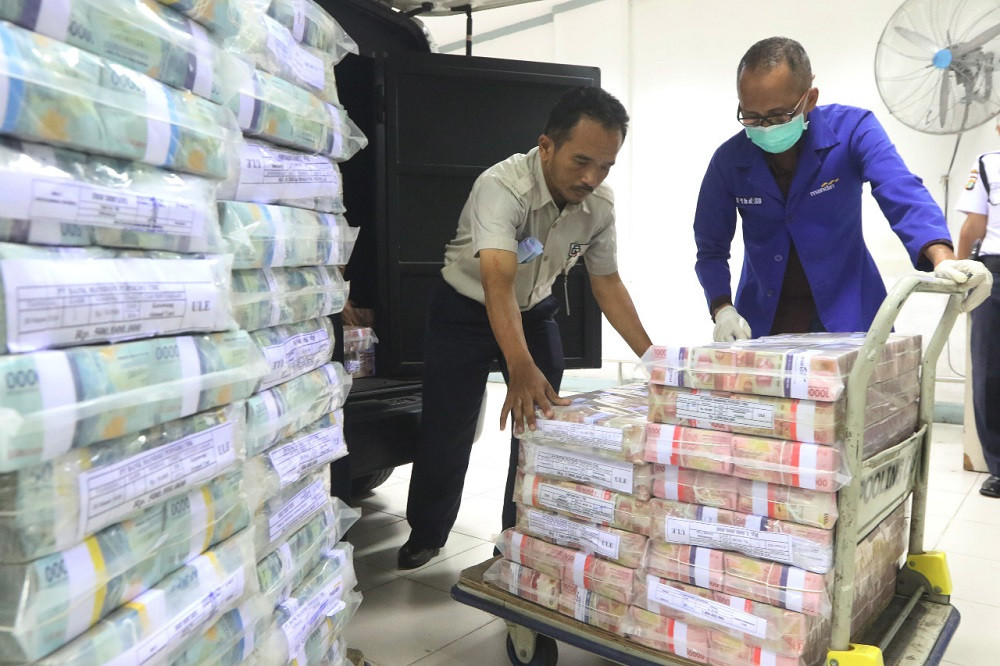Popular Reads
Top Results
Can't find what you're looking for?
View all search resultsPopular Reads
Top Results
Can't find what you're looking for?
View all search resultsIndonesian fiscal management on brink of being unsustainable
This fiscal financing through money creation, if excessive, is very dangerous for the economy.
Change text size
Gift Premium Articles
to Anyone
T
he Indonesian economy has shown a weakening trend in the last 15 years (2005-2019). One of the main reasons for the weakness has been the sharp decline in export commodity prices since 2011, particularly coal, palm oil and rubber prices, which together accounted for nearly 40 percent of total non-oil and gas exports in 2011.
Commodity prices initially rose rapidly until mid-2008 following the relaxation of global monetary policy, especially of the Federal Reserve during the era of Alan Greenspan. Commodity prices then fell sharply following the global financial crisis, approaching the price levels of early 2004. Fortunately, this sharp decline in commodity prices did not last long.
The global quantitative easing (QE) policy to fight the global recession in 2007/2008 made commodity prices rise again. This second wave of commodity booms lasted until early 2011 before they fell sharply following the tapering off the QE. As a consequence, the value of Indonesia's exports also steadily decreased from US$203 billion in 2011 (the highest) to only $145 billion in 2016.
In line with the decline in commodity prices and the value of Indonesia's exports, gross domestic product (GDP) growth in nominal terms also decreased from an average of 19.6 percent annually in the first five-year period (2005-2009) at a compound rate, to 12.5 percent in the second five-year period (2010-2014) and 8.43 percent in the third five-year period (2015-2019).
Consequently, the decline in nominal GDP growth was followed by a decline in government revenue growth from an average of 17.5 percent per year (2005-2009) to 12.9 percent (2010-2014) to 5 percent (2015-2019). This led to a sharp fall in the ratio of government revenue to GDP after its rise in the early 2000s.
The ratio of government revenue to GDP reached 19.8 percent in 2008, which was the highest ratio since 2000. Thereafter, this ratio steadily declined to 15.4 percent in 2014, 12.4 percent in 2019, then reached the lowest level of 10.6 percent in 2020. This low ratio indicates that the government's fiscal and financial condition was difficult to sustain.
The ratio of government debt to GDP is also worsening, which initially fell sharply from 47.1 percent in 2005 to 24 percent in 2012, but then increased to 30.4 percent in 2019 and jumped to an estimated 39 percent in 2020.
This government debt curve is also in line with the curve of interest expense to GDP ratio, which fell from 2.6 percent in 2005 to 1.2 percent in 2012, but then increased to 1.7 percent in 2019 and then rose sharply to 2.0 percent in 2020.
It should be noted that the interest expense in the 2020 fiscal budget did not reflect the actual figure. This is because the 2020 budget deficit is largely borne by Bank Indonesia (BI), which is required to purchase government debt securities on the primary market or as a non-competitive bidder. The latter means that BI is obliged to purchase the government debt securities in case there are too few interested buyers.
Overall, BI has absorbed Rp 650 trillion ($45.8 billion) of the total budget deficit of Rp 956 trillion. Most of these securities were non-interest bearing securities for public goods financing, and BI is required to return the charged interest on securities to the government.
This fiscal financing through money creation, if excessive, is very dangerous for the economy. In addition to causing inflation in the medium term, purchasing government bonds on the primary market will adversely affect BI's balance sheet and may result in loss of confidence from international investors.
Because this policy is not part of a monetary policy, BI will find it difficult to reabsorb the excess money supply when the economy starts to improve, which will trigger inflation.
Government fiscal and financial conditions as described above are very fragile. On the one hand, the government revenue to GDP ratio fell sharply to only 10.6 percent in 2020. On the other hand, the interest expense to GDP ratio continued to swell and reach 2.0 percent in 2020. This means that the remaining government revenue available for spending is only 8.3 percent of GDP should the government impose a balanced budget.
However, this is hardly possible because this ratio is far below the realization of the government spending ratio in the past, which reached an average of 18.8 percent per year in 2005-2009, 17.5 percent in 2010-2014, 15 percent in 2015-2019 and 16.9 percent in 2020 due to pandemic and recession fiscal spending.
To maintain the spending level of 2020, the government is expected to impose a fairly aggressive fiscal policy, thereby increasing the government debt to GDP ratio to an estimated 55 percent in 2022, close to the legal ceiling of 60 percent, which will likely be exceeded by 2023.
Next, the government revenue to GDP ratio that stood very low at around 10.6 percent in 2020, with a declining trend, will inevitably cause a serious fiscal problem that could lead to a recession. The problem becomes more complex when the interest expense is continuously increasing.
The interest expense to GDP ratio of 2 percent is equivalent to around 19.2 percent of the total government revenue in 2020, which is much larger than the International Monetary Fund reference of fiscal sustainability that should not exceed 10 percent of government revenue.
Finally, the primary balance, which was continuously in deficit from 2012 to 2020, has also worsened. The 2020 primary deficit stood at 3.9 percent of GDP (estimated figure) and is expected to remain large in 2021 and 2022.
All of the above indicators show that the government's fiscal condition is unsustainable and, therefore, requires drastic changes. The government must reform the fundamentals of its fiscal policies sooner rather than later to save the economy without causing major shocks.
To fix this fiscal problem, the government has no other choice but to increase its revenue as this is the main source of its fiscal problems. Reducing government spending and the budget deficit would not solve the economy’s current problems. On the contrary, it would cause a major shock to the economy.
Efforts to increase government revenue must be achieved through tax increases. Tax revenues currently contribute around 80 percent of total government revenue. Other revenue comes from natural resources, the amount of which is highly dependent on commodity prices. In fact, the revenue from natural resources tends to decrease in the long run; therefore, it cannot be relied upon as the government's main source of income.
***
The writer is managing director of Political Economy and Policy Studies (PEPS).










